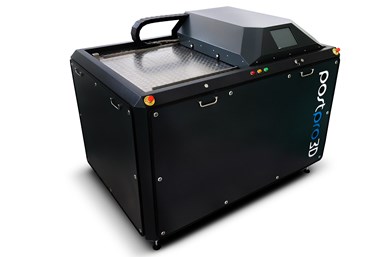Collaboration Results in 3D Postprocessing Productivity Boost
Additive Manufacturing Technologies teamed up with Mitsubishi Electric to develop an integrated automation solution for its PostPro 3D chemical vapor smoothing machine.
Share
Read Next

PostPro 3D chemical vapor smoothing machine
Additive Manufacturing Technologies Ltd. (AMT) teamed up with Mitsubishi Electric to develop an integrated automation solution for its PostPro 3D chemical vapor smoothing machine, giving 3D printing postprocessing a 50 times productivity boost.
The PostPro vapor smoothing machine fully automates surface finishing of 3D printed parts, boosting productivity from a few parts finished every hour up to hundreds of parts per hour and making 3D printing cost-effective for higher volume production.
Mitsubishi Electric’s automation products helped create the first fully automated Underwriters Laboratories (UL)-approved postprocessing machine for 3D printed plastic parts. This solution is based on Mitsubishi Electric’s MELSEC iQ-F Series compact PLC, HMIs, SCADA and MELFA articulated arm robots which are offered as a system option.
The machine occupies a working space of 2.5 m2 and can smooth an object surface to 1-micron precision, similar to that of injection molding. PostPro 3D can handle a variety of thermoplastic polymers.
The automated postprocessing is made possible by using a series of predefined parameter sets and algorithms that are applied to PostPro proprietary physicochemical Boundary Layer Automated Smoothing Technology (BLAST) process.
The 3D printed parts, created via laser or high-speed sintering, HP Multi Jet Fusion, or fused deposition modeling technology, can be loaded into the postprocessing machine manually or using an integrated Mitsubishi Electric six-axis robotic arm that further improves productivity. Several parts can be postprocessed at the same time within PostPro 3D, provided they are made of the same materials and require identical surface finishing.
Once the parts are inserted, it is possible to select the desired surface roughness as well as additional surface qualities. The processing data is analyzed and stored in real-time for continuous process and machine monitoring. After a cycle time of typically 90-120 minutes, the smoothing operation is complete, and the parts are released and ready to use.
Related Content
-
Chuck Jaws Achieve 77% Weight Reduction Through 3D Printing
Alpha Precision Group (APG) has developed an innovative workholding design for faster spindle speeds through sinter-based additive manufacturing.
-
BMW Expands Use of Additive Manufacturing to Foster Production Innovations
The BMW Group is manufacturing many work aids and tools for its own production system using various 3D printing processes, with items such as tailor-made orthoses for employees, teaching and production aids, and large, weight-optimized robot grippers, which are used for such things as carbon fiber-reinforced polymer roofs and entire floor assemblies.
-
How AM Enables Cobot Automation for Thyssenkrupp Bilstein (Includes Video)
The shock absorber maker has responded to its staffing shortages through extensive use of collaborative robots. In-house 3D printing makes this possible by providing the related hardware needed to complete the cobot-automated cells.













